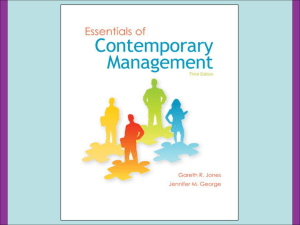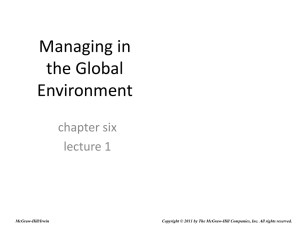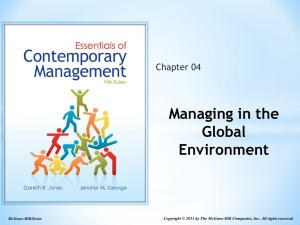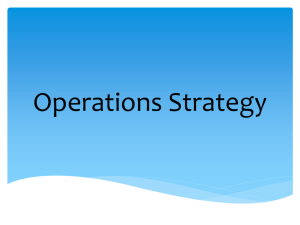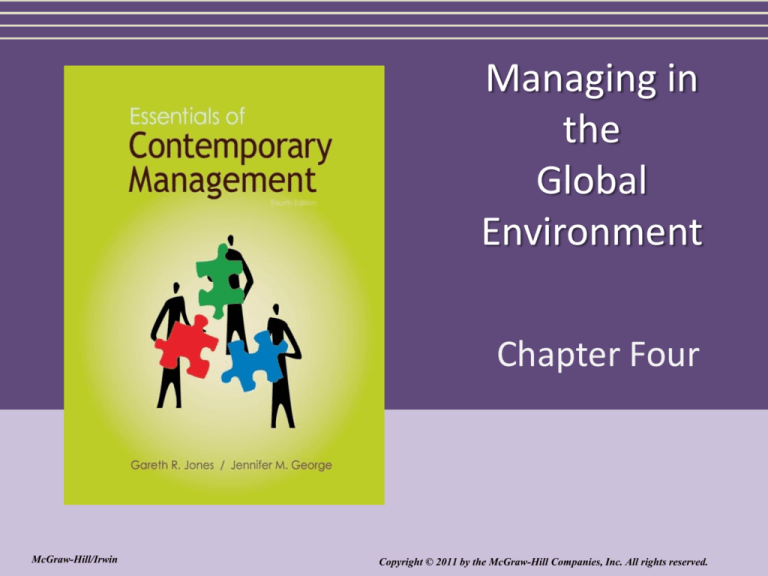
Managing in
the
Global
Environment
Chapter Four
McGraw-Hill/Irwin
Copyright © 2011 by the McGraw-Hill Companies, Inc. All rights reserved.
Learning Objectives
LO1 Explain why the ability to perceive, interpret, and
respond appropriately to the organizational
environment is crucial for managerial success
LO2 Differentiate between the global task and global
general environments
LO3 Identify the main forces in a global task and
general environments, and describe the challenges
that each force presents to managers
4-2
Learning Objectives
LO4 Explain why the global environment is becoming
more open and competitive and identify the
forces behind the process of globalization that
increase the opportunities, complexities,
challenges, and threats that managers face
LO5 Discuss why national cultures differ and why it is
important that managers be sensitive to the
effects of falling trade barriers and regional trade
associations on the political and social systems of
nations around the world
4-3
What is the Global Environment?
• Global Organizations
• Global Environment
– Organizations that
– Set of global forces and
operate and compete
conditions that operate
in more than one
beyond an organization’s
country
boundaries
– Affects a manager’s
ability to acquire and
utilize resources
– Uncertain and
unpredictable
Any examples??
4-4
Forces in the Global Environment
Figure 4.1
4-5
What is the Global Environment?
• Task Environment
– Set of forces and conditions that originate with:
Suppliers, Distributors, Customers & Competitors
– Affects an organization’s ability to obtain inputs
and dispose of its outputs
– Influences managers on a daily basis
4-6
What is the Global Environment?
• General Environment
– The wide-ranging global forces that affect an
organization and its task environment
– Economic, Technological, Socio-cultural,
Demographic, Political and Legal forces
4-7
1-The Task Environment/Suppliers
• Suppliers
– Individuals and organizations that provide an
organization with the input resources that it needs
to produce goods and services
– Provide raw materials, component parts, labor
(employees) = inputs!
4-8
1-The Task Environment/Suppliers
• Relationships with suppliers can be difficult
– Material shortages, unions, lack of substitutes
• Suppliers that are the only source of a critical
item are in a strong position to raise prices
• Managers can reduce these supplier effects by
increasing the number of suppliers per input
• Is this always possible or practical?
4-9
Global Outsourcing
• Global Outsourcing
– Purchase of inputs from foreign suppliers or the
production of inputs abroad to lower production
costs and improve product quality or design
4-10
2-The Task Environment/Distributors
• Distributors
– Organizations that help other organizations
sell their goods or services to customers
• Powerful distributors can limit access to
markets through its control of customers in
those markets.
4-11
3-The Task Environment/Customers
• Customers
– Individuals and groups that buy the
goods and services that an
organization produces
– Identifying an organization’s main
customers and producing the goods
and services they want is crucial
to organizational and managerial
success
4-12
4-The Task Environment/Competitors
• Competitors
– Organizations that produce goods
and services that are similar to a
particular organization’s goods and
services
– Strong competitive rivalry
results in:
-Price competition & lower prices
-BUT falling prices reduce access
to resources and lower profits
4-13
The Task Environment-Barriers to Entry
• Barriers to Entry
– Factors that make it difficult and costly for the
organization to enter a particular task
environment or industry
4-14
The Task Environment-Barriers to Entry
• Economies of scale
– Cost advantages associated with large
operations
• Brand loyalty
– Customers’ preference for the
products of organizations currently
existing in the task environment
• Government regulations
– Government policies that may limit
imports of goods
4-15
Barriers to Entry and Competition
Figure 4.2
4-16
1-General Environment/Economics
• Economic Forces
– Interest rates
– Inflation
– Unemployment
– Economic growth
– Other factors that affect the general health and
well-being of a nation or the regional economy of
an organization
4-17
2-General Environment/Technology
• Technological Forces
– Outcomes of changes in the technology that
managers use to design, produce, or distribute
goods and services
• Products may become obsolete (Other People’s Money)
• Better/faster/more efficient products and services
4-18
3-General Environment/Sociocultural
• Sociocultural Forces
– Pressures emanating from the social structure of
a country or society or from the national culture
4-19
3-General Environment/Sociocultural
• Social structure
– Arrangement of
relationships
between individuals
and groups in society
• National culture
– Set of values that a
society considers
important and the
norms of behavior
that are approved or
sanctioned in that
society.
4-20
4-General Environment/Demographics
• Demographic Forces
– Outcomes of change in, or changing attitudes
toward, the characteristics of a population, such
as age, gender, ethnic origin, race, sexual
orientation, and social class
• Most industrialized nations are experiencing the aging
of their populations
4-21
5-General Environment/Political-Legal
• Political and Legal Forces
– Outcomes of changes in laws and regulations include:
• Deregulation of industries
• Privatization of organizations
• Increased emphasis on environmental protection
• Free exchange of resources and capital
4-22
The Global Environment-EU
Figure 4.3
4-23
The Process of Globalization
• Globalization
– Set of specific and general forces that work
together to integrate and connect economic,
political, and social systems across countries,
cultures, or geographical regions, resulting in:
– Nations become increasingly interdependent
• Changes in Globalization result from Capital
– Human/People- Financial/MoneyResources/Raw Materials and Political/Power
4-24
Effects of Free Trade on Managers
• Declining Trade Barriers
– Opened enormous opportunities for managers to
expand the market for their goods and services
– Allowed managers to now both buy and sell goods
and services globally
• Tariff
– Tax imposed on
imported goods
4-25
The Role of National Culture
• Values
– Ideas about what is good, desirable and beautiful
• Provides conceptual support for democracy, truth,
appropriate roles for men, and women
• Usually not static but very slow to change
• Norms
– Unwritten informal codes of conduct
4-26
Norms
• Folkways
– Routine social
conventions of
everyday life
• Mores
– Norms that are
considered to be
central to functioning
of society and to
social life
4-27
Hofstede’s Model of National Culture
Figure 4.4
4-28
Hofstede’s Model of National Culture
• Individualism
– A worldview that values individual
freedom and self-expression and
adherence to the principle that
people should be judged by
individual achievements rather
than by their social background
4-29
Hofstede’s Model of National Culture
• Collectivism
– A worldview that values subordination of the
individual to the goals of the group and
adherence to the principle that people should be
judged by their contribution to the group
4-30
Hofstede’s Model of National Culture
• Power Distance
– The degree to which societies accept the idea that
inequalities in the power and well-being of their
citizens are due to differences in individuals’
physical and intellectual capabilities and heritage
– Low power distance = more equality/opportunity
– High power distance = economical poor countries
– US/UK = low power distance/high individualism
– S.A. = high power distance/low individualism
4-31
National Culture and Global Management
• Management practices that are effective in one
culture might be troublesome in another
• Managers must be sensitive to the value systems
and norms of an individual’s country and behave
accordingly
• Examples include:
– Wages
– Holidays
– Teamwork
4-32
Discussion Question?
What technology has had the biggest impact on
business in the last 50 years? Think about…..
New technology has made the world smaller
Technology has changed how a manager manages
Money spent on IT department now vs. 50 years ago
Can you imagine not being “connected” in some way?
Could you go without IM or email for a week?
What happens to businesses when networks go down?
A. Internet B. Cell Phones C. Computers D. Email
4-33

